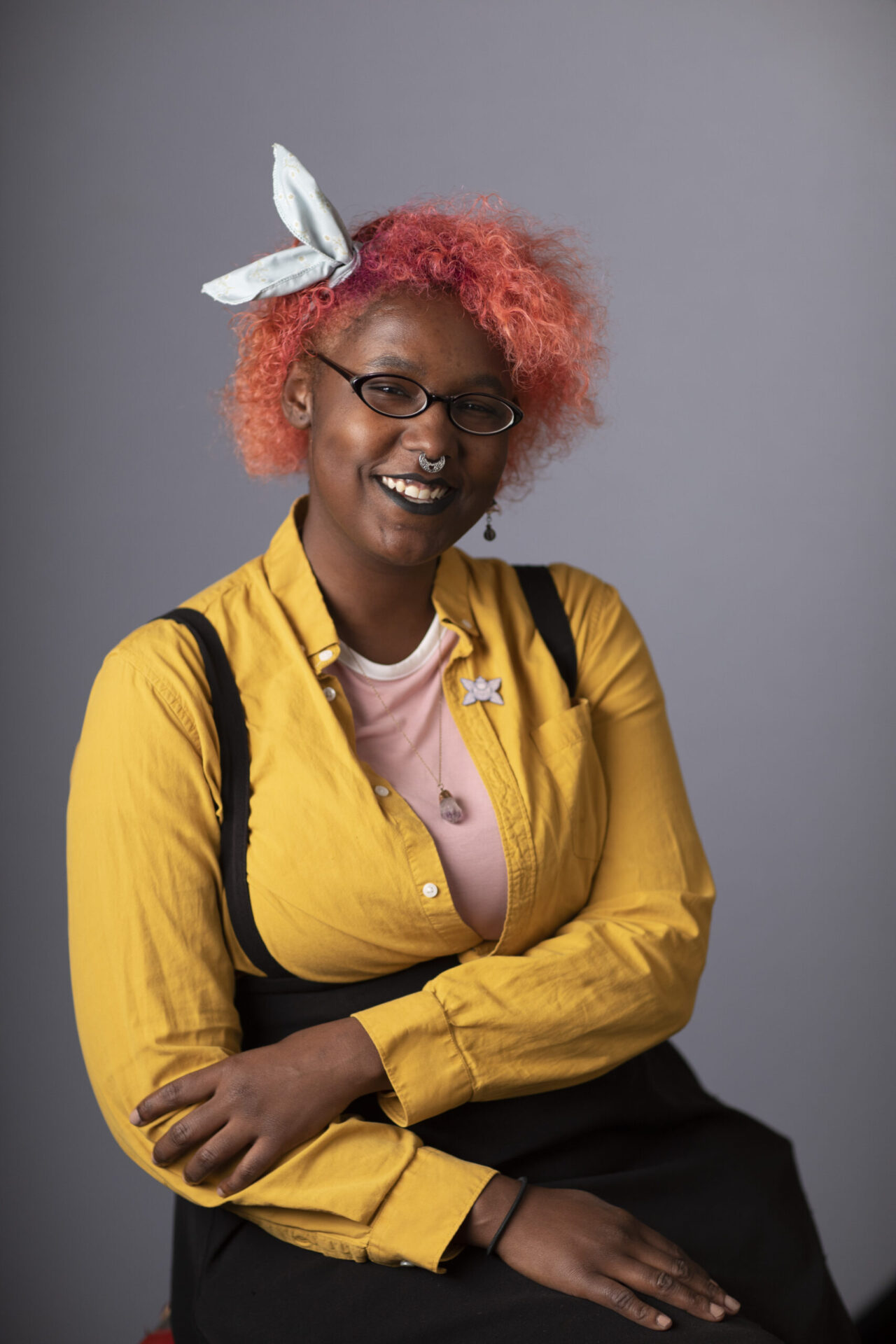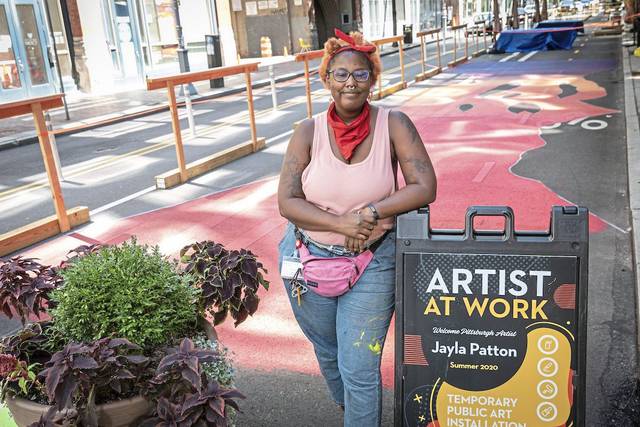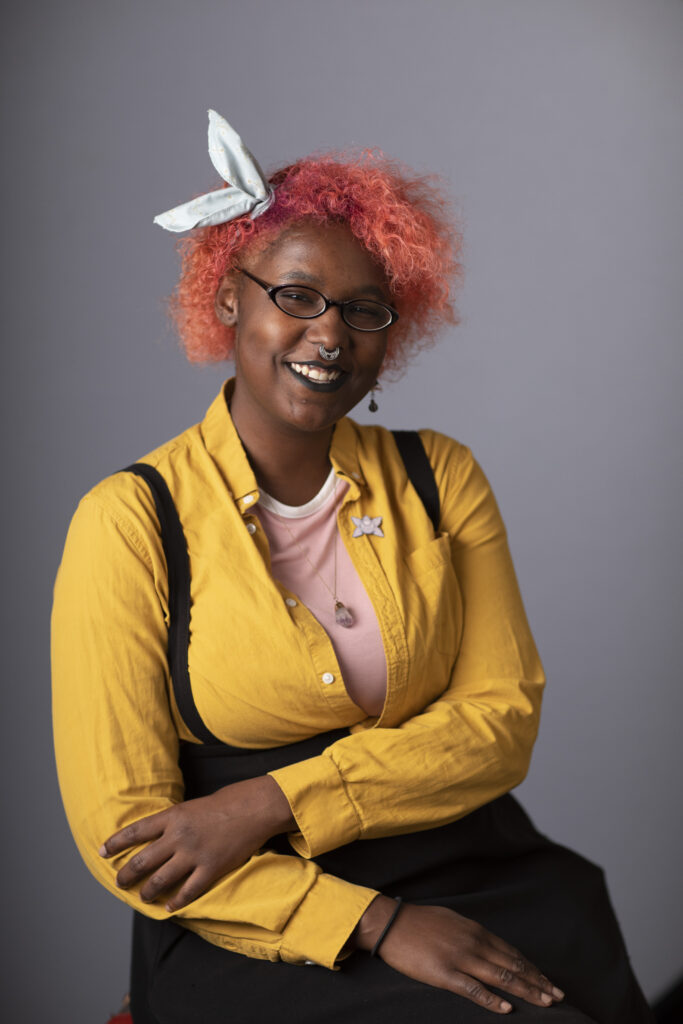Meet Jayla Patton: a teaching artist, professor, and maker extraordinaire. You may recognize Jayla’s work from around town, including a 2020 large-scale street mural in Downtown Pittsburgh. Jayla recently joined Remake Learning’s TOMORROW LIVE! series to discuss the importance and future of maker learning as a means for unearthing and growing human potential, social justice, and the future of education. As a teaching artist and adjunct professor at Carnegie Mellon University, her work at the intersection of the arts, digital fabrication, K-12 education, out-of-school time learning, and higher education allows Jayla to embrace her passions while simultaneously sparking those of learners throughout the region.
Like so many other creative journeys, Jayla Patton’s began with a common muse: boredom. As a teenager without access to cable television, entertainment required a bit more ingenuity than plopping down on the couch to channel surf.
It was during this time that Jayla came across a “How to Draw Manga” book and dove in, hopeful for something fun to pass the time. As a fan of anime, learning how to draw manga—a style of Japanese comic book and cartooning medium—piqued Jayla’s attention; she was immediately hooked on learning.
“My backstory involves a young person who didn’t like school at all,” Jayla shared. “In my high school [career], I think I missed something like 90 days of school, but I went on to become a teaching assistant the Manchester Craftsmen’s Guild and that kind of opened my love of teaching and learning very specific things that were in line with what I wanted to do.”

Over the years, Jayla’s passion, talents, and experiences took her from the pages of a how-to book to graduation from The Art Institute of Pittsburgh with a Bachelor of Applied Science in Media Arts and Animation. All along the way, Jayla has been an influential force in Pittsburgh’s creative community.
When asked about her role in Pittsburgh’s maker movement, a smile spreads across Jayla’s face: “I think it’s the fact that I have students who have gone on to do what I do, which is really amazing. I have had young people who I have met while [I am] selling comics who came up [to me] and were like ‘How do you do this?’ and I give them all the information they need and six months later they are doing the exact same thing and then passing that on.”
It was her time as one of the only Black vendors at Tekko 2016, Pittsburgh’s premier anime con (short for convention), that Jayla cites as a formative moment and the heart of her love for maker education.
At this particular con, Kit Temko, then 14-years-old, was making their way to the vendor floor, searching for merchandise from manga series Haruhi Suzumiya. A Black anime fan immersed in the con community, Kit was also struggling with their family’s issues regarding their sexuality. As they entered the vendor hall, amongst a sea of mostly white and Asian faces, Kit spotted something they never thought they would see at an anime con.
“I saw a drawing of a Black girl with rainbow flowing hair and a pink soul symbol on her chest,” Kit recalled. “All the art with Black and LGBTQ+ themes blew me away. Seeing natural, Black hair and gay content made my heart explode.”
Jayla and Kit instantly bonded over Kit’s thirst for guidance on getting started as a Black artist. Over the years, Jayla and Kit have worked together and supported one another. During the summer of 2018, Kit began working with Jayla at Assemble, the Garfield-based makerspace and community space for arts and technology.
“It was…really inspiring to see how she inspired the Black girls she taught and how students latched on to her,” Kit explained.
“Jayla is an excellent role model for girls—especially Black girls—who find themselves in the in-between space or not fitting in the buckets that society puts us in,” emphasized Nina Barbuto, Executive Director of Assemble.
“It goes beyond representation to have Black teachers for students,” echoed Anne Chen, another Tech Shop and Assemble colleague. “Jayla has identified the ways that art supplies leave out certain skin types. She has an arsenal of experience and experimentation to correct these inherent inequities and give students the power to imagine themselves into the worlds they create on paper.”
Jayla, too, is quick to point to her passions as a catalyst for connection with her learners. Her own learning pathway was crucial in how she now approaches her role as a teaching artist and maker educator.
“When I was in college, my professors hated anything anime…anything manga, anything with big eyes that wasn’t considered an ‘industry standard’ more in line with American-styled animation…they would just…write you off as uncreative,” Jayla shared with a hint of exasperation in her voice.
Whether her focus is on cosplay (creating, wearing, and photographing character-inspired costumes), digital fabrication, or general maker skills, Jayla makes it clear that she brings her interests to the table and that learners should do the same.
During her time as a teaching artist with the Academic Institute at the Allegheny County Jail, working with young, predominately Black men, her passion for learners’ interests helped inspire some of the work she is most proud of. Her initial training proved to be nerve-wracking, but Jayla approached the experience with the same enthusiasm and love for creativity and human connection that are evident in all other facets of her work.
“[For me], this was about creating an opportunity for escapism. I didn’t want to force the students to do things they didn’t want to do.”
Mary Brenholts, Director of Artists in Schools & Communities for the Pittsburgh Center for Arts and Media, knew Jayla was the right teaching artist to work with these young men.
“She is so giving, on so many levels… and she is always right there with the students, working alongside them,” explained Mary.
Jayla created cross-curricular connections between her art lessons and content like Language Arts, assisting with the purchase of manga for the students. And while the jail’s restrictions on tools like scissors and materials like paint would be a deterrent for many, Jayla got creative with her approaches, guiding learners through graffiti art with pre-cut bubble letter sheets and watercolor pencils.
“Jayla couldn’t fix [everything], but she would do everything she could to provide them with the opportunity to express themselves,” Mary added.

Jayla’s influence also extends beyond her learners. Her teaching artist peers often tout the benefits of learning with and from Jayla.
Naomi Chambers, a collaboration partner of Jayla’s, emphasized just how critical Jayla’s mentorship as a teaching artist has been. Feeling burnt out by numerous teaching artistries following her graduation, Naomi reached out to Jayla for guidance.
“She reignited my passion in a way that allowed for me to do what I love and make the money I need while also helping me develop coping mechanisms and a skillset to deal with the red tape of some organizations,” Naomi said. “Jayla doesn’t allow those things to bother her or impact her.”
Whether it is the convention circuit, criminal justice system, youth makerspaces, higher education, or professional networks, Jayla’s impact on the maker education community is a testament to the importance of staying true to oneself and making space for your learners to do the same.
“Jayla has a way of working [in which] she forges through, brings her full self, and isn’t afraid of her own emotions,” summarized Nina Barbuto. “Her love of anime and leadership has been instrumental in bonding with students and helping them to become artists and entrepreneurs.”
Want to learn more about Jayla? Visit www.jaylapatton.com to find her portfolio, shop, and contact information. Know an amazing maker educator we should spotlight next? Submit the Making It Happen nomination form!
